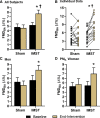Time-Efficient Inspiratory Muscle Strength Training Lowers Blood Pressure and Improves Endothelial Function, NO Bioavailability, and Oxidative Stress in Midlife/Older Adults With Above-Normal Blood Pressure
- PMID: 34184544
- PMCID: PMC8403283
- DOI: 10.1161/JAHA.121.020980
Time-Efficient Inspiratory Muscle Strength Training Lowers Blood Pressure and Improves Endothelial Function, NO Bioavailability, and Oxidative Stress in Midlife/Older Adults With Above-Normal Blood Pressure
Abstract
Background High-resistance inspiratory muscle strength training (IMST) is a novel, time-efficient physical training modality. Methods and Results We performed a double-blind, randomized, sham-controlled trial to investigate whether 6 weeks of IMST (30 breaths/day, 6 days/week) improves blood pressure, endothelial function, and arterial stiffness in midlife/older adults (aged 50-79 years) with systolic blood pressure ≥120 mm Hg, while also investigating potential mechanisms and long-lasting effects. Thirty-six participants completed high-resistance IMST (75% maximal inspiratory pressure, n=18) or low-resistance sham training (15% maximal inspiratory pressure, n=18). IMST was safe, well tolerated, and had excellent adherence (≈95% of training sessions completed). Casual systolic blood pressure decreased from 135±2 mm Hg to 126±3 mm Hg (P<0.01) with IMST, which was ≈75% sustained 6 weeks after IMST (P<0.01), whereas IMST modestly decreased casual diastolic blood pressure (79±2 mm Hg to 77±2 mm Hg, P=0.03); blood pressure was unaffected by sham training (all P>0.05). Twenty-four hour systolic blood pressure was lower after IMST versus sham training (P=0.01). Brachial artery flow-mediated dilation improved ≈45% with IMST (P<0.01) but was unchanged with sham training (P=0.73). Human umbilical vein endothelial cells cultured with subject serum sampled after versus before IMST exhibited increased NO bioavailability, greater endothelial NO synthase activation, and lower reactive oxygen species bioactivity (P<0.05). IMST decreased C-reactive protein (P=0.05) and altered select circulating metabolites (targeted plasma metabolomics) associated with cardiovascular function. Neither IMST nor sham training influenced arterial stiffness (P>0.05). Conclusions High-resistance IMST is a safe, highly adherable lifestyle intervention for improving blood pressure and endothelial function in midlife/older adults with above-normal initial systolic blood pressure. Registration URL: https://www.clinicaltrials.gov; Unique identifier: NCT03266510.
Keywords: NO; exercise training; flow‐mediated dilation; hypertension; oxidative stress; reactive oxygen species.
Conflict of interest statement
None.
Figures





Comment in
-
Take a Deep, Resisted, Breath.J Am Heart Assoc. 2021 Jul 6;10(13):e022203. doi: 10.1161/JAHA.121.022203. Epub 2021 Jun 29. J Am Heart Assoc. 2021. PMID: 34184555 Free PMC article. No abstract available.
References
-
- Virani SS, Alonso A, Benjamin EJ, Bittencourt MS, Callaway CW, Carson AP, Chamberlain AM, Chang AR, Cheng S, Delling FN, et al. Heart disease and stroke statistics‐2020 update: a report from the American Heart Association. Circulation. 2020;141:e139–e596. DOI: 10.1161/CIR.0000000000000757. - DOI - PubMed
Publication types
MeSH terms
Substances
Associated data
Grants and funding
LinkOut - more resources
Full Text Sources
Medical
Research Materials

